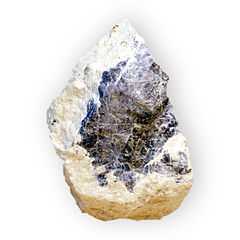Cancrinite
| Cancrinite | |
|---|---|
|
Cancrinite | |
| General | |
| Category | Feldspathoid |
| Formula (repeating unit) | Na6Ca2[(CO3)2|Al6Si6O24]·2H2O |
| Strunz classification | 09.FB.05 |
| Crystal symmetry |
Hexagonal pyramidal H-M symbol: (6) Space group: P 63 |
| Unit cell | a = 12.67(9) Å, c = 5.15(4) Å; Z=1 |
| Identification | |
| Color | Grey-green, white, yellow, blue, orange, reddish |
| Crystal habit | Rare as prismatic crystals; typicallt massive |
| Crystal system | Hexagonal |
| Twinning | Rare - lamellar |
| Cleavage | Perfect on {1010}, poor on {0001} |
| Fracture | Irregular/uneven |
| Tenacity | Brittle |
| Mohs scale hardness | 5-6 |
| Luster | Vitreous, greasy, pearly |
| Streak | White |
| Diaphaneity | Transparent, translucent |
| Specific gravity | 2.42 - 2.51 |
| Optical properties | Uniaxial (+/-) |
| Refractive index | nω = 1.507 - 1.528 nε = 1.495 - 1.503 |
| Birefringence | δ = 0.012 - 0.025 |
| References | [1][2][3] |
Cancrinite is a complex carbonate and silicate of sodium, calcium and aluminium with the formula Na6Ca2[(CO3)2|Al6Si6O24]·2H2O. It is classed as a member of the feldspathoid group of minerals; the alkali feldspars that are poor in silica. Yellow, orange, pink, white or even blue, it has a vitreous or pearly lustre; a hardness of 5-6 and an uneven conchoidal fracture. It is unusual among the silicate minerals in that it will effervesce with hydrochloric acid due to the associated carbonate ions.
Found originally in 1839 in the Ural Mountains, it is named after Georg von Cancrin, a Russian minister of finance.[1]
